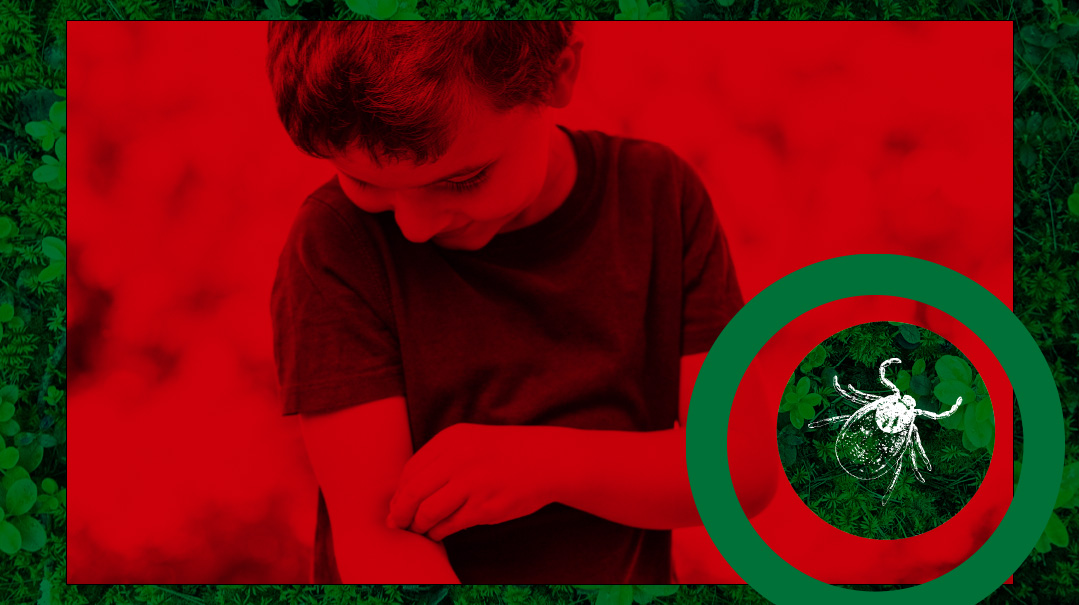Bugs in the System

How Lyme disease mounts a stealthy, silent attack on the unsuspecting

It’s hard enough to watch a family member suffer through a painful physical or mental illness when you know what the problem is. But just imagine that your previously happy, healthy spouse or child suddenly develops a mysterious cluster of debilitating symptoms that your doctor can’t seem to diagnose or treat: fever, joint and muscle aches, abdominal pain, emotional volatility, difficulty focusing in class, visual impairment. You then go from one specialist to another, but none of them seem able to pinpoint a cause or offer any relief.
That’s what happened to Suri B., whose ten-year-old son came home from camp bearing a plastic bag with a large tick inside, courtesy of the camp nurse. “The tick is pretty large, so it was probably feeding on your son for some time,” she said.
Suri knew that tick bites can transmit Lyme disease, so she brought the tick to her pediatrician. The tick was sent to the lab for analysis, and the doctor expressed relief: “It’s a dog tick, not a deer tick, so it doesn’t carry Lyme,” she said. “You have nothing to worry about.”
Three months later her son developed severe abdominal cramps that seemed to have nothing to do with what he ate. In the attempt to cure his symptoms, Suri brought him to a battery of specialists who subjected him to X-rays, other testing, hospital visits, and medications.
Before long, this formerly outgoing, funny, and talented child withdrew socially, and his mental state spiraled downward. At first, his pediatricians dismissed it as normal mood swings of pre-puberty and the pressures of school and social life. But her son’s mental state didn’t get better with time. Fearing he might have been traumatized by abuse, she took him to a psychotherapist.
It was the therapist who proposed testing for Lyme again. Dog ticks don’t carry Lyme, but they can carry other non-Lyme disease causing infections that can likewise attack both body and brain.
“When I went back to my pediatrician, he reluctantly gave me a referral to test for Lyme and PANDAS,” Suri says. “My son tested negative for both.”
Suri now knows that standard tests can produce both false negatives and positives, and generally don’t pick up other similar Lyme-type infections that produce the same symptomology. But it took several more years of suffering to learn that.
With a negative Lyme test and no clear path forward, her son deteriorated mentally and physically. He developed migraines, lethargy, depression, tremors, blurred vision, tachycardia, muscle and body aches, night sweats, brain fog, plus the original presenting complaint of abdominal cramps. He was prescribed a regimen of anti-anxiety and anti-depression meds as well as sleeping pills for his insomnia.
“I barely recognized my son anymore,” Suri says. “He was being pumped with meds that seemed to be doing more harm than good and created their own side effects. After two years, I finally read a magazine article that discussed other non-Lyme co-infections and gave a reference to Life for Lyme [a Lakewood-based Jewish organization that advises and advocates for Lyme patients, also known as Chai for Lyme]. I was put in touch with a doctor in Williamsburg who has experience treating Jewish patients who summer in the country. She took 20 vials of blood, and my son was diagnosed with three Lyme-like co-infections. That doctor saved his life.”
Not every physician is open to the idea that Lyme disease underlies all those perplexing chronic conditions, and many are reluctant to engage in prolonged, expensive testing and treatment.
But just about anyone who spends time in the Catskills or lives in wooded areas knows about watching out for ticks, whose bites can transmit Lyme disease. People know the drill: If you find a tick on you, bag it and send it to a lab. If you develop a rash and fever and your antibody test comes up positive, you’ll be prescribed an antibiotic.
If detected and treated promptly with antibiotics, most Lyme patients recover. But the situation often becomes more complicated for those who aren’t diagnosed quickly or at all, or who miss treatment at a critical moment (not everybody sees a tick, and not everybody develops the telltale “bullseye” rash). Others are treated but still don’t seem to recover. Some of these people spend years suffering with persistent, ever-worsening conditions, and the expenditure in time, suffering, and money drains families of resources both emotional and financial.
Just One Bite
Lyme disease and related tick-borne illnesses are complex medical issues, although Lyme-like symptoms, with rashes and flu-like symptoms, have been on record in the medical literature for centuries. Some early European physicians managed to associate the disease with transmission by worms or ticks. When a frozen corpse reputed to be 5,000 years old was discovered in the Alps and brought in for analysis, the DNA of the “Ice Man” contained foreign DNA determined to be Lyme bacteria (the Ice Man, however, died of a head wound).
It wasn’t until 1971 that a dermatologist in Wisconsin recognized this type of rash from earlier case reports and treated it successfully with penicillin. In 1977, when a group of children developed symptoms consistent with juvenile rheumatoid arthritis, their mothers lobbied the Center for Disease Control to investigate. As the children lived in the area of Lyme, Connecticut, the disease henceforth became known by the name of the town where it was officially studied and diagnosed.
“Lyme disease is caused by a spiral bacteria (spirochete) called Borrelia burgdorferi, which is classically transmitted by the black legged tick also referred to as the deer tick (lxodes scapularis),” Dr. Martin Bluth, director of Translational Research for the Department of Pathology, Chief of Transfusion Medicine and Blood Donor Services and assistant director of Clinical Laboratories at Maimonides Health, tells Mishpacha. “Symptoms generally appear three to 30 days after the bite, and can include fever, headache, fatigue, and a characteristic skin rash called erythema migrans (often referred to as a “bullseye” rash) which occur in 70-80 percent of infected patients which can swell to up to a foot in width.” He explains that there are tests to determine the presence of antibodies for the bacteria, and if the test is positive, the standard treatment is to prescribe antibiotics such as doxycycline.
In 2021, the CDC reports, the incidence of reported Lyme cases in the U.S. was about 475,000 per year in the US, and the number continues to rise. But some believe those numbers are underestimated.
“There are far more patients with the infection, since only a fraction of cases are reported,” according to Pamela Weintraub, author of Cure Unknown: Inside the Lyme Epidemic (St. Martins Griffin, 2023). In fact, there’s enough public health concern that June has been termed Lyme Awareness Month; and Senator Chuck Schumer has announced the allocation of 160 million federal dollars for education, surveillance, and research into the disease in Nassau and Suffolk counties.
Numerous factors have contributed to the spread and severity of the disease. In Recovery from Lyme Disease (Skyhorse Publishing, 2021), Dr. Daniel Kinderlehrer spells them out: The number of trees in the Eastern seaboard doubled in the past 70 years, and people have moved out of the cities into suburban areas. The population of deer increased from an estimated 300,000 in 1930 to three million in 2014, probably because natural predators such as cougars, bears, and wolves have decreased. Other animals such as rabbits, raccoons, chipmunks, squirrels, opossums, and mice carry deer ticks and other disease-bearing ticks as well.
While Lyme disease was once thought to be concentrated in the Northeast and Great Lakes regions, global warming has allowed ticks to survive in many new regions. Dr. Kinderlehrer proposes that other factors may decrease the lack of resistance to such disease in the 21st century: a lack of vitamins and minerals such as Vitamin D and zinc, poor diet, exposure to toxic chemicals such as fluorocarbons, a lack of fresh air and exercise, and the weakening of close families and communities, which is associated with depression and anxiety.
Although Lyme disease was originally associated with the bacteria borrellia burgdorferi, it is now clear that there are many varieties of tick-borne infections that may be passed on individually or simultaneously, such as babesia, anaplasma, ehrlichia, or bartonella.
“The CDC lists 13 infections a tick can carry,” says Avrumi Safier, volunteer director of Life for Lyme, a subdivision of the Orthodox Jewish Chamber of Commerce that promotes Lyme awareness, distributes tick kits, and deals with patient referrals.”
For the best prevention, Safier suggests that bungalow colonies spray their grounds, and that camps, which do typically spray their grounds, should not neglect to spray the grounds near adjoining woods. People in these areas should spray their clothing with a repellant called permethrin (a product the army uses, but which can be irritating if sprayed directly on the skin) or a less-irritating spray called picaridin — and especially make sure to spray your shoes, as ticks don’t fly.
The Lyme bacteria and related infections are transmitted through the saliva of the tick. A person may not feel the bite at the moment it happens, because the tick simultaneously transmits an analgesic that numbs the pinch.
“You might feel it later, when you go home and take a shower,” says Dr. Alfred Miller MD, a Mayo clinic-trained internal medicine specialist and former full professor at the University of Texas Medical Center (now retired). In at least half of all cases, the bitten person will develop the characteristic “bulls-eye” shaped rash, but many people show no symptoms, and many others never see a tick.
Dr. Miller says that while a tick bite sets off the infection, there are other ways the infection can be transmitted – from a pregnant mother to her fetus, or through other forms of close contact.
The Lyme spirochete, if not wiped out quickly, will often lodge in body tissues or organ systems. The bacteria retreats into a cystic structure, sequestered in body tissues, that becomes impenetrable to antibiotics and won’t even trigger an immune response.
“You can give IV antibiotics in these cases and it’s like running water off a duck’s back,” Dr. Miller says. “The blood tests that measure antibodies won’t find anything. In these cases, you need provocative antibiotics that are able to open the cysts.”
That’s the reason more and more physicians are considering Lyme and related spirochetes to be the root cause behind mysterious cases of fibromyalgia (the disease lodges in muscles and joints), digestive issues, and psychiatric issues (the disease lodges in the neurological system). Since the disease may lodge in one body system or several, and can affect so many different areas, it means each case involves a different set of symptoms and treatment.
“Lyme disease has been called ‘the great imitator,’” Dr. Bluth says, “because the symptoms it produces mimic other diseases.”
And sometimes, Lyme’s malicious masquerade can lead doctors down faulty paths to treatments that may be ineffective or even exacerbate symptoms.
It Made Me Crazy
When her five-year-old daughter came home with a tick bite, Ahuva, herself a nurse, was told by her pediatrician to “watch and wait.” Six months later, her daughter developed anxiety and joint pain, which the doctor attributed to growing pains and the start of first grade. A Lyme test came back negative, but then her daughter developed tics and emotional swings. It took close to a year to get the proper testing to indicate the presence of Lyme and start effective treatment, in this case a combination of antibiotics with supplemental herbal remedies to boost the immune system.
At Life for Lyme, founder Esther Honig deals with desperate families who call from all over the world for help. This organization provides advocacy, education, health care referral and support for patients suffering from acute and chronic illnesses, many that stem from tick borne illness. “It’s crisis after crisis,” she says. “The number of patients suffering from chronic illness is staggering and growing. The clinical network that we utilize, who are approached after the standard medical system has been exhausted, has demonstrated remarkable success through additional testing and personalized treatment approaches. Our success stories include those who were wheelchair bound and are now walking, those who were infertile who are now parents, those who were paralyzed, suicidal, or psychiatrically committed who are now functional, and so many others. We utilize the strength of the Orthodox Jewish Chamber of Commerce to help navigate any governmental, insurance, or other roadblocks to provide advocacy for our patients.”
Bite Me: How Lyme Disease Stole My Childhood, Made Me Crazy, and Almost Killed Me, is Ally Hilfiger’s memoir that begins at the moment her father, fashion mogul Tommy Hilfiger, committed her to a mental hospital at age 18, fearful she would commit suicide. She had suffered for eleven years with physical symptoms that no doctor could explain, from joint pain to night sweats, memory loss, nausea, and brain fog. Writer Amy Tan, in her essay collection The Opposite of Fate, likewise describes the way that, after attending an outdoor wedding in Dutchess County, New York, she developed a mysterious rash, aches, nausea, flu-like symptoms and insomnia. When she began having hallucinations and seizures and feared she was losing her mind, a doctor finally determined she’d contracted Lyme disease. Today, still not completely cured due to remaining lesions in the brain, she serves on the board of the Lyme Disease Association.
Testing, Testing
In order to get a diagnosis for Lyme disease, the first step is the ELISA test, which looks for Lyme-specific antibodies indicating that the body is fighting the disease. If the ELISA test is positive, a second test, known as the Western blot test, is administered, which is presumably more specific for Lyme antibodies.
The problem with Lyme tests, say many clinicians, is that they’re outdated and/or not sufficiently accurate, not finely tuned enough to pick up the entire spectrum of Lyme and its co-infections.
“The ELISA test produces false negatives 50 percent of the time,” Dr. Miller says. “When it comes to the Western blot test, many labs don’t analyze certain key protein bands that indicate Lyme or its co-infections, which makes the test indeterminate. You have to be sure your test is sent to a lab that will do a complete analysis.”
There are 20 species of borrelia that exist on every continent, he says, which all create the same pathology, and respond to the same medications. But if you test only for one and not the others, you may come to erroneous conclusions. You need a lab that picks up co-infections like babesia, bartonella, and erlichia. “These are not technically bacterial infections, and each one requires a different medication,” he says.
But testing and treatment can be extremely expensive. “If a case goes beyond conventional diagnoses and treatment, insurance companies may not pay for it,” says Dr. Bluth. Life for Lyme helps the Jewish community obtain thorough and accurate testing, assuring that people receive a complete panel that’s less likely to miss something.
Dr. Amy Offutt, the president-elect of the International Lyme and Associated Diseases Society, told Mishpacha there are researchers working on creating better testing for Lyme and related diseases. She tests patients when she suspects Lyme is present, but even if the test comes back negative, she will treat for it if the history and symptoms match. “I base my diagnoses on what I see clinically,” she says. “The big five are fatigue (often severe), pain, cognitive issues, mood disorders, and sleep problems.”
The current pressures on doctors to process patients quickly—the typical patient visit in the US is estimated at under 20 minutes—means that doctors can easily miss a subtle diagnosis. Dr. Joseph Burrascano, in Recovery From Lyme Disease, avows, “Today’s scenario of five-minute office visits does not address complex, multifaceted illnesses. The usual scenario is one problem, one diagnostic test, and one treatment (or no treatment) based on the result of that test.”
“The approach today is ‘treat’em and street’em,’” says Dr. Offutt, who left a position at a hospital system where they wanted her to see 30 patients or more each day to open her own office where she typically sees about seven patients a day. Intensive medical sleuthing cannot occur in short office visits.
Elusive Cure
If Lyme is treated promptly, usually with antibiotics such as doxycycline or erthyromycin, 80 to 90 percent of those treated will recover completely. Most patients are given two weeks to a month of treatment, but if there is no recovery in that time frame, doctors may prolong antibiotic treatment, sometimes resorting to IV antibiotics to avoid the side effects of long-term oral antibiotics.
Dr. Miller explains that the efficacy of antibiotics depends on the life cycle of the bacterium. All bacteria consume antibiotics during their reproductive cycles, which differ between species. Bartonella reproduces every 24 hours, while borrelia only reproduces every 28 days. If you miss that moment, the antibiotic won’t be effective and the bacteria will retreat into a cystic structure, sequestered in body tissues that becomes impenetrable to antibiotics and won’t even trigger an immune response.
Even if you give IV antibiotics in such a case, it’s like running water off a duck’s back,” Dr. Miller says. “The blood tests that measure antibodies won’t find anything. What you need are provocative antibiotics that are able to open the cysts.”
Sometimes the disease itself suppresses the immune system, in which case it doesn’t produce antibodies – the very thing the tests look for – and so the diagnosis slips under the radar again. Patients present with all sorts of symptoms ranging from chronic fatigue to psychosis, and specialists try to treat the symptoms. But if the true cause is Lyme or a co-infection, those treatments won’t get to the real source of the problem.
Since Lyme can attack one or more body systems, treatment depends on the individual case and symptoms.
“I see what the patient has already tried, what tests were done, and what helped,” Dr. Offutt says. “Sometimes I’ll prescribe a small amount of an antimicrobial and ask the patient to keep me informed how they’re feeling. If the person cannot tolerate antibiotics some herbals, like cryptolepsis for example [an anti-inflammatory] might help, and herbal combinations are also sometimes helpful, depending upon a patient’s unique condition and circumstances.
Functional and integrative medicine physicians have looked into herbal supplements to boost immune function, ease the severity of symptoms, and counteract the side effects of antibiotics (these remedies are suggested in addition to antibiotics, not in place of). Dr. Ying Zhang and colleagues at Johns Hopkins have run studies that suggest that some herbal remedies, such as Japanese knotweed, cat’s claw, cryptolepsis, and Chinese skullcap root are effective in helping patients heal. Dr. Stephen Buhner’s book, Healing Lyme Disease Coinfections: Complementary and Holistic Treatments for Bartonella and Mycoplasma is a good resource for herbal supplements.
Lyme for Life’s Avrumi Safier adds that vitamin supplementation can be helpful as well. “The infection can drain the body of nutrients,” he says. “So physicians often supplement with Vitamins B and D. Some add supplements that support liver function, since dying bacteria can create toxicity in the liver.”
Desperate Measures
Not every doctor believes that Lyme disease is as damaging or prevalent as the Lyme advocates believe. “Many infectious disease doctors don’t like the new expanded criteria for diagnosing Lyme,” Dr. Bluth says. “They see it as a vehicle for quacks who prey on the desperate. There are doctors prescribing months of antibiotics, but there isn’t enough good data to show if it’s working. The Center for Disease Control and Prevention (CDC) website cites various studies of patients who underwent a long regimen of antibiotics for Lyme and didn’t do better than the placebo group. Some studies have reported patients that may have been hurt by such prolonged antibiotic treatment. This does not mean that in certain cases, non-conventional treatments are ineffective, rather it provides a cautionary tale for those patients and their families that are at their wits end about to embark on such a treatment plan.”
Dr. Yitzchak Ariel, an infectious disease specialist in practice at the Cooperman Barnabas Medical Center in Livingston, N.J., agrees that standard antibiotic treatment doesn’t always work for Lyme patients, but he sees no evidence that long-term antibiotic treatment is helpful in eliminating the disease. In addition to the CDC studies, he cites articles from the New England Journal of Medicine which tested the effects of long-term antibiotics against a placebo.
“In most of these, some patients got better, some got worse, and others showed no change,” he says. “There was no compelling evidence that the long-term antibiotics did much to help. You have to weigh the small chance of helping against the negative side effects, of the antibiotics and the risk of patients developing resistance to the antibiotics.”
When Dr. Gary Wormser, an infectious disease specialist at New York Medical College and Westchester Hospital, argued in a 2007 study that there is little evidence for long-term Lyme disease, it created a considerable outcry. The study was cited by the CDC but later taken off the site because of protests from those who believe otherwise. “Dr. Wormser is considered an expert. He was the editor of the guidelines on Lyme for the Infectious Disease Society of America,” Dr. Ariel explains. “But this created tremendous contention amongst certain sectors of public that were impacted by Lyme disease.”
Dr. Bluth notes that there hasn’t been enough consistency among patients who were helped to show solid proof of a “cure.”
“If you try eight different treatments spread over two years, it’s hard to determine what worked,” Dr. Bluth says. “The ‘bah-humbuggers’ say the person would’ve gotten better anyway. But since the disease presents so differently in different people, there’s no one magic bullet for all of them.” Dr Bluth also advocates taking a step back. “There are many reasons for such chronic clinical presentations, Lyme is just one of them. It is important to search for other causes including hormonal, metabolic, toxic, environmental, and infectious contributions prior to claiming Lyme as the sole cause.”
Dr. Amy Offutt says she had no idea Lyme was such a controversial topic when she joined ILADS seven years ago. “I was just looking for a way to help my patients,” she says. “I’m not interested in going against other doctors—if they have a treatment that works, great. But I believe the best doctors are lifelong learners who are open to new ideas and treatments.” ILADS has begun offering a one-day course for medical professionals entitled Fundamentals of Vector-Borne Diseases, and so far it has been well received within the medical establishment.
While patients who complain of long-term symptoms such as joint pain, headaches and chronic fatigue might be seen as malingerers or hypochondriacs, Dr. Ariel believes that such people are suffering from real symptoms, but posits that those symptoms are the secondary effects of damage that Lyme disease already produced.
“A person who breaks his hand may develop arthritis,” he explains by way of comparison. “The bone is fixed, but arthritis may ensue. In the same way Lyme may affect certain systems in the body and leave damage even after it’s been treated. The Lyme is gone, but the patient still suffers from myalgia, joint pain or nervous system issues, etc. In such cases you don’t treat the Lyme anymore, but deal instead with the specific sequelae of the disease.”
Suri B. warns against falling into the hands of quacks or unscrupulous practitioners. “You meet all kinds of crazies when you’re desperate for a cure,” she says. “People find gurus, herbalists, self-proclaimed mekubalim.”
Dr. Bluth says that especially with herbal treatments, there should be more controlled evidence as to their efficacy and a controlled approach to their composition.
“Even our standard mainstream blockbuster drugs may only work on 40-50 percent of the population, and often differently for men and women,” he says. “When it comes to herbals, you ideally want to know when and where the plant was harvested, how it was prepared, and how concentrated it is, but that information is not always available”.
“And then there are doctors out there asking for thousands of dollars to start managing such a case,” he adds. “Such physicians are often no longer part of the mainstream medical establishment and adopt a cash pay system since insurance will frequently not pay for the tests or treatments they prescribe. But when people are suffering and there’s no conventional help, they will go to anyone with a story of success and do anything to get help, even in the absence of clinical proof.”
Underlying Lyme
One of the most shocking aspects of Dr. Alfred Miller’s research is the association he has made between Lyme disease and neurodegenerative diseases such as ALS, MS, Parkinsons, dementia, and even autism.
In 2008, Dr. Miller’s 43-year-old daughter-in-law received the horrifying diagnosis of ALS. She saw specialists at three top-tier academic institutions, had MRIs of her brain and physical exams, and received the terrible ALS prognosis. Since she lived in the Boston area, she was tested for Lyme using the ELISA and Western blot tests. “The ELISA test has a 50 percent false negative rate, and the Western blot test omits protein bands 31 and 34, which are specific to Lyme,” he says. He sent his daughter-in-law’s test to a lab that didn’t omit those bands and found that she indeed had Lyme disease. Once treated, her ALS symptoms disappeared.
Since then, he has seen other ALS-diagnosed patients recover when the right tests are positive for Lyme and they receive treatment. A 26-year-old mother of two in Florida, who had been bedridden with ALS and told there was no hope, tested positive for borrelia and bartonella and finally got the treatment she needed. “Her husband sent me a video of her going up and down the stairs at home,” Dr. Miller says.
He notes an interesting correlation: ALS was first called “Lou Gehrig’s Disease” after the baseball player who famously contracted it. Lou Gehrig played baseball for the Hartford, Connecticut Senators, about 50 miles from Lyme, and then bought a house a few miles from Lyme. “There’s been an uptick in ALS in football players, Italian field workers, and golfers,” he says. “Doctors thought the football players got it from head injuries. But all these people work and play in grassy areas where ticks live.”
He believes some cases of Parkinson’s disease may also be undiagnosed, untreated Lyme. He notes that actor Michael J. Fox, an advocate for Parkinson’s and himself a sufferer, once told an interviewer on a talk show – and this was long before he contracted Parkinson’s – that the week before he’d been ill with Lyme disease.
While this is a purely anecdotal connection, some advocates believe that multiple sclerosis symptoms may also be a result of Lyme. The state of Vermont has two times the national average of MS among its population; it also has the highest rate of Lyme in the country. “If you superimpose a map of MS occurrence over a map of Lyme occurrence, you find exactly the same distribution,” Dr. Miller claims.
He also believes that sometimes dementia may also mask Lyme infections. He cites a January 2013 article in the New England Journal of Medicine that discusses the case of an 80-year-old woman who, over a four-month period, displayed a precipitous decline in memory and withdrawal from her family. Doctors thought it was Alzheimer’s. Because the woman had had a prior history of lymphoma, her doctors did a lumbar puncture, and in the spinal fluid they found borrelia miyamatoi, a species very close to Lyme. He cites another case in which a child who began displaying symptoms of autism reverted to neurotypical behavior after treatment for Lyme.
In the meantime, it seems that progress in testing, diagnosis and treatment for Lyme disease and its coinfections will be pushed forward by the immense swell of grassroots advocates and organizations pushing for more thorough research.
“Of course, not everything is Lyme,” Dr. Offutt qualifies. “But on the other hand, not everything is not.”
Dr Bluth echoes a similar sentiment “Lyme disease presents a very difficult road that takes different directions, often over years with undue pain and frustration. It is good that there is increased awareness, advocacy, and support from a variety of different domains. This will provide additional avenues to mature new promising diagnostic laboratory biomarkers as well as investigate what treatments work, and what does not to improve health and decrease confusion.”
“In parallel, if you witness a tick on you or someone, please act and find a healthcare person that you trust and will work with you, rather than wait. That can make all the difference.”
(Originally featured in Mishpacha, Issue 969)
Oops! We could not locate your form.







